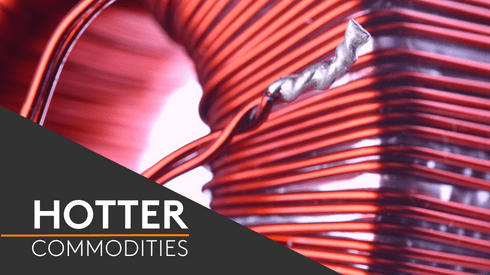The most-traded November copper contract on the SHFE stood at 50,280 yuan ($7,647) per tonne as of 03:10 BST, down 530 yuan or 1% from its closing price in the previous session. Meanwhile, the LME’s three-month copper price was similarly weaker, dropping $62 to $6,464 per tonne on Select so far.
On Wednesday, the Fed left interest rates unchanged – as was widely expected – but hawkish language from the central bank, seemingly pointing to another rate increase this year, sent the dollar higher.
Markets had thought that the recent softness in US core inflation may have persuaded the Fed to hold off raising rates again this year – but it does not seem it will, ANZ Research noted.
“The Fed did not surprise, but the underlying signal was more hawkish than markets expected, shooting the dollar higher,” it added.
The dollar index was recently up 0.14% at 92.58.
The renewed strength in the dollar has put downward pressure on the SHFE base metals complex this morning, with prices broadly weaker. Lead was the lone metal in positive territory as it continued to find support from supply tightness amid continuing environmental inspections in China.
Lead up, rest lower
- The SHFE’s most-traded November lead contract rose 140 yuan to 20,785 yuan per tonne.
- “Lead supply is still under pressure due to the environmental inspections and shortage of concentrates, so it is unlikely that the supply tightness will ease in the short term,” China’s Galaxy Futures said.
- The SHFE’s most-traded January nickel contract decreased 860 yuan to 89,060 yuan per tonne.
- “Environmental inspections continue in Jiangsu Province, while the transportation and manufacturing of ferro-nickel in Wuxi has largely been suspended. Downstream consumption of nickel is also under pressure,” Galaxy Futures noted.
- The SHFE’s most-traded November aluminium contract dipped 75 yuan to 16,980 yuan per tonne.
- The SHFE’s most-traded November zinc contract went down 230 yuan to 25,390 yuan per tonne.
- The SHFE’s most-traded January tin contract declined 510 yuan to 145,710 yuan per tonne.
Currency moves and data releases
- The dollar index was recently up 0.14% at 92.58.
- In other commodities, the Brent crude oil spot price was down 0.3% to $56.12 per barrel, and the Texas light sweet crude oil spot price edged 0.02% higher to $50.70.
- In equities, the Shanghai Composite was up 0.14% to 3,370.84.
- In data on Wednesday, US existing home sales for August disappointed at 5.35 million, below the forecast of 5.46 million.
- Later today, we have the European Central Bank’s (ECB) economic bulletin, UK public sector net borrowing, EU consumer confidence as well as US data that includes unemployment claims, the Philly Fed manufacturing index, house price index and the CB leading index.
- In addition, ECB president Mario Draghi is speaking.
| LME snapshot at 0310 London time | ||
| Latest 3M LME Prices | ||
| Price ($/t) | Change since yesterday’s close ($) | |
| Copper | 6,464 | -62 |
| Aluminium | 2,179 | 2 |
| Lead | 2,454 | -6 |
| Zinc | 3,100.5 | -31.5 |
| Tin | 20,635 | 10 |
| Nickel | 11,205 | -175 |
| SHFE snapshot at 1010 Shanghai time | ||
| Most traded SHFE contracts | ||
| Price (yuan/t) | Change since yesterday’s close (yuan) | |
| Copper (November) | 50280 | -530 |
| Aluminium(November) | 16980 | -75 |
| Zinc(November) | 25390 | -230 |
| Lead(November) | 20785 | 140 |
| Tin (January) | 145710 | -510 |
| Nickel (January) | 89060 | -860 |
| Changjiang spot snapshot on September 21 | ||
| Range (yuan/t) | Change (yuan) | |
| Copper | 50,330—50,350 | -460 |
| Aluminium | 16,590—16,630 | 240 |
| Zinc | 26,010—26,810 | 30 |
| Lead | 21,250—21,450 | 550 |
| Tin | 143,000—145,000 | 0 |
| Nickel | 88,900—89,500 | 50 |




